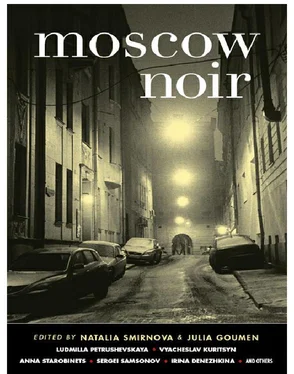And only three days later…
The flashing lights of the police car cast an unnatural blue pall on the gray stump of a body covered with a blanket. The figure lay on a stretcher that floated slowly into the yawning mouth of the ambulance. But I caught a glimpse of tangled hair and a wet forehead amidst the absurdly blue uniforms of the orderlies. Her face was uncovered, so she was alive. Inspector Bullet gave me a dark look and said, “The reason I asked you to come right away was that if she dies, I’m gonna have to interrogate your underage client. There’s an overcoat here too. Looks like it’s all true.”
“I’d rather tell you her story myself,” I said, thinking hard. “It would make more sense.”
“Well?”
“Nice guy, funny, youngish, sun-bleached hair, tan, tall?” I asked.
“Far from it. Not very tall. The overcoat he wore dragged along on the ground behind him. The victim says the coat was strange, like something from the Stalin era. Other than that—well, maybe he was tan, maybe funny. Why shouldn’t he be funny? So much fun to bash in a girl’s head. They’re probably gonna have to drill a hole in her skull. They say it’s that serious. She went with him on her own at first, and then later she suspected something wasn’t quite right… Yep. That’s about it.”
The investigation reached a dead end very quickly. Two construction workers, migrants, one tall and one short, who had been painting the building on the corner of 2nd and 3rd Peshchanaya Streets, vanished into a thin air. This greatly surprised their foreman, who couldn’t locate his countrymen after returning from Moldavia. To find their whereabouts or prove anything was virtually impossible, since the photographs of the suspects that were soon faxed from their hometown, a place called Yassy, were only suitable for a trash can. So the building with the unfinished paint job returned to its peaceful slumber among the sticky lime trees and sounds of car alarms.
“We can’t issue ‘wanted’ posters or arrest an overcoat without its owner,” said the inspector. “But you know what I think? I think this is your department. After you stopped in the other day, I called all the old geezers from our precinct. They’re better than any archive. Thought maybe there had been something like what you described two years ago, before I began working here. Turned out there was a case in 1973. Right here in Birch Grove Park. Then again, where else would someone work the walls with a girl? So there was this sex maniac who wore a wide-brim hat and an old-fashioned overcoat, who was always on the lookout for schoolgirls. Funny thing was that the girls didn’t even hesitate. He took them to some broken-down barracks near Khodynka and made them wear white socks and a school uniform with a white apron. When he got busted, he threatened that the entire police force would have hell to pay when they found out who he really was. He hinted that he was some big shot in the Communist Party, or even one of the higher-ups in the government. To make a long story short, instead of going to jail, he ended up in a funny farm—your department, in other words. Never came back from there. He’d be in his nineties by now, I’d say. And he was a local, not a construction worker from Moldavia. Period. Case closed… What do you say to that?”
Quite frankly, I couldn’t say anything at all, except a few standard comments about fetishism.
But fetishism isn’t contagious. Especially when there’s no direct contact. And fetishists rarely choose the same location twice.
Lighting up a cigarette, I sat down on a chair on the balcony and put my bare feet up on the railing. I had thought that I lived in one of the best neighborhoods in Moscow. Right next to the Sokol subway station and the large triangle of Bratsky Park, with its stately old lime trees. The park ends right at a lane of chestnuts, straight as an arrow, bordering an elegant square. That lane runs up to the famous Birch Grove Park, as big as a small forest. To live in a place surrounded by trees and green parks—what more could you wish for? Well, for one thing, that there weren’t sexual predators roaming around in them.
But what could I do? I had (along with Inspector Bullet) very odd facts at my disposal. There was not one, but three maniacs, all strangely attractive to underage girls. The girls followed them willingly; my young patient even seduced him herself. Only one of them put up any resistance; but even she followed him voluntarily at first—a man she’d never seen before wearing an overcoat. She went with him to a remote, deserted corner of the park. And it was only when they got there that something happened she didn’t like.
So, three maniacs. The second was short, since the coat dragged on the ground. The first one was taller; the coat only came down to his knees. And the third maniac was already history—also featuring an overcoat, however.
If there’s only one overcoat, then two different people would have had to wear it. As for the two builders from Moldavia, one of them could have just borrowed it from the other, and… and interesting things began happening to them.
But what about the 1973 maniac, who also wore an “old-fashioned overcoat,” for god’s sake? Old-fashioned even in 1973? When was it in style, then? The ’50s? ’40s?
The cigarette smoke drifted over the tops of the poplar trees, behind which stood gray brick buildings that looked like gingerbread houses. The clicking of a woman’s high heels, fast and nervous, resounded on the concrete somewhere below.
The next day I went to visit the inspector with a silly question: had they found any link between the 1973 case and today’s pedophiles from Moldavia? But, of course, there was no link. And, of course, no one wondered back in 1973 what had happened to the gray overcoat that the sex maniac wore to go skirt-chasing. Inspector Bullet had read in the 1973 file that the maniac had had a whole underground bunker, like an abandoned bomb shelter, right on the edge of Birch Grove Park. The police might have kept the white socks or the coat; but only the socks would probably have made good material evidence.
“What about the bunker?” I asked. “What happened to it? Where is it?”
“Who cares about the bunker, doc? When we come across a place like that, you know, a basement or an attic, we just seal it up and check the locks from time to time. So that winos or bums can’t live there. I’m sure that was what happened to the bunker. Sealed up and forgotten. Come on, let’s go. I’ll show you why we have Comrade Stalin and his minister of internal affairs, Lavrentiy Beria, to thank for a good cop shop.”
“Why Beria?” I asked absently, lost in my own thoughts.
Inspector Bullet didn’t answer. Instead, he proudly motioned me to follow him down the corridor, where it ended at a plywood door. He opened it, revealing another door behind it. This one was made of heavy, rough cast iron, painted blood-brown. It had something like a ship’s steering wheel, two feet in diameter, attached to it. No, it wasn’t a ship’s wheel—it looked more like the lock on a bank safe. I was standing in front of the door to a huge safe, the height of a grown man, covered in a slapdash way with multiple layers of paint. Numerous iron levers and knobs stuck out of the door—all parts of the locking mechanism.
“Does it work?” I asked in a grim voice, staring at the magnificent contraption.
“You bet,” said Inspector Bullet. “We have the key, it weighs almost a pound. But frankly, none of us has ever felt like going behind the door.”
He paused significantly, enjoying my confusion.
“No mutant rats or skeletons in rotten trench coats there, though,” he added shortly, and wiped his large face with his hand. “But I suggest you don’t go in there, either. Because… well, doc, I guess you’ve figured out this is an entrance to a bomb shelter. And our station is like the front lobby of the shelter. We’re on the corner of Peshchanaya Square and 3rd Peshchanaya Street, right? We go into the bomb shelter from here, and using underground passages we can walk all the way over to the lane of chestnuts on your 2nd Peshchanaya. Think there’s not a bomb shelter in your basement? It’s just locked. But if you go down into the basement, sooner or later you’ll end up in front of a metal door just like this one here. And behind it you’ll find a passageway all the way to the Sokol subway station, or even the airport station, where the old airport use to be, on the former Khodynka Field. There was a secret subway line that went all the way there from the Kremlin. So, you go for a stroll underground, and when you figure you’re lost, you start banging on this two-foot-thick door from the inside. But no one’s going to open it, because even if someone’s there, they won’t hear you. It could get lonely, don’t you think? Especially when it’s pitch-black in there.”
Читать дальше












